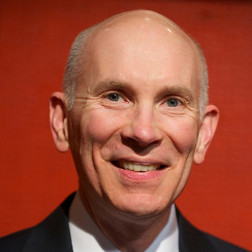GV Expo: C-SPAN’s Kennedy Talks Efficiency in the Digital Age
WASHINGTON—“Efficient doesn’t mean second-rate or standing still.” This quote summed up much of Robert G. Kennedy’s1 p.m. address to the 2016 Government Video Express and National Drone Show Wednesday.

Robert Kennedy
His subject was “The C-SPAN Perspective: Opportunities and Challenges in the Digital Era” — however, his message was more timeless than tied to 2016.
Kennedy, who is president and co-CEO of C-SPAN, joined the public access network in 1987 as its top financial officer. But C-SPAN was born in 1979, dreamed up by founding Chairman Brian Lamb, and enabled by the House of Representatives’ decision to allow TV coverage of their sessions. At its launch, C-SPAN became the sixth national satellite network to go on air; HBO was the first.
C-SPAN gets its funding from affiliates who choose to carry it. They pay a 6 cents per household per month licensing fee to broadcast the programming. That comes out to about $68.8 million per year, with an additional $300,000 in additional revenue coming in from other licensing fees, like video sales. In contrast, CNN and Fox both have annual budgets of around $900 million annually. C-SPAN’s operating cost per hour ranges from $2,300 to $3,000, with the peak spending during presidential election years.
Today, C-SPAN’s platforms have prolierated. “We’ve come a long way from using geosynchronous satellites,” Kennedy remarked.
Over its three main TV channels, the network broadcasts 7,000 hours per year to about 96 million homes, all of which can receive it in HD. In the 1990s, C-SPAN also added a radio station in Washington, D.C., now WCPS(FM), which is now available on the C-SPAN Radio app, which also features podcasts that were converted from existing video content.
C-SPAN.org features both live and archival video content—everything that’s aired on the network since 1987 (when its broadcasts were first recorded on SVHS) is available on the website. All of this content is searchable, and C-SPAN also offers a tool which viewers can use to create their own clips and/or share videos on social media platforms. The process of adding archival video content is highly automated.
The initial digitization began in the early 2000s, with the bulk of it being finished by 2010, and the official, full launch was in 2013. C-SPAN uses Amazon Web Services to stream its gavel-to-gavel coverage online and to storage backups of the files.
C-SPAN’s field productions are an instance in which the network maximizes efficiency. In 2016, C-SPAN can do as much with three cases and a small Sony switcher as they could do with a whole room full of equipment 20 years prior.
But the next frontier, Kennedy says, is informational efficiency. C-SPAN is currently partnering with Dalet to create a unified, automated system that is tied to both its closed captioning and website and the electronic programming guides that cable providers supply. The latter is especially important because C-SPAN is constantly updating its schedule on the fly, due to the unpredictability of Congressional sessions. Because the majority party, not C-SPAN, controls the cameras on the House and Senate floors, this kind of flexibility is especially important.
C-SPAN has also been experimenting with Facebook Live for about six months. One of its most famous uses was the June 23 House sit-in, in which Democrats protested the blocking of a gun control measure.
Another popular and ongoing recent social media initiative is #ElevatorCam, which broadcasts from the press pool camera that is set up in the lobby of Trump Tower in New York.
What’s next? Drones and 360-degree cameras are on the horizon. Both have applications in use for establishing shots outside, as well as educational programming. However, Kennedy notes, it is difficult to make concrete predictions about the future.
C-SPAN has also created a few Snapchat filters, and the network is also looking ahead to potential applications for virtual or augmented reality, both of which may have educational value.
Ultimately, Kennedy says, “We always evaluate things as to how they support our mission.”
Get the TV Tech Newsletter
The professional video industry's #1 source for news, trends and product and tech information. Sign up below.
